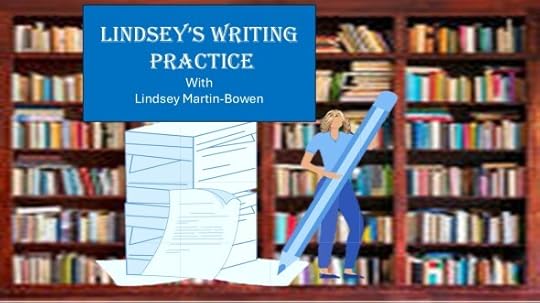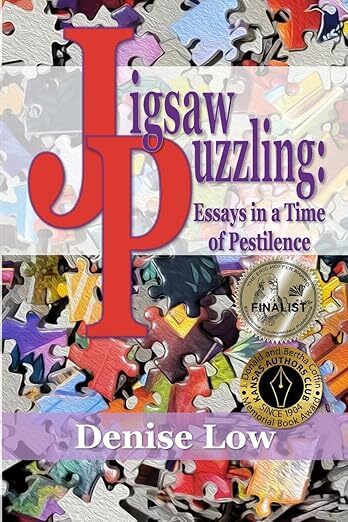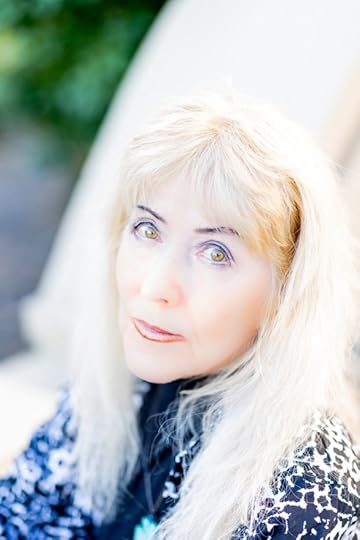Lindsey’s WRITING PRACTICE- Review: “Jigsaw Puzzling: Essays in a Time of Pestilence” by Denise Low

By Lindsey Martin-Bowen
“I never underestimate the power of a single puzzle piece. It fits within a whole, like each moment of my unfolding life story.”
—Denise Low
Hey, Dear Readers, this month you’ve earned a break: No writing exercise. Instead, I’m posting an engaging book review by a well-known poet, professor, fiction and prose writer, and former Kansas Poet Laureate, Denise Low. Jigsaw Puzzling: Essays in a Time of Pestilence amazed me—and I had to share the experience with others. Please enjoy it!
Who’da thunk it? Such an accomplished, widely-published poet, fiction and scholarly writer, and esteemed university professor she is—yet she’s writing about and documenting info about jigsaw puzzles?
Yes!

This brilliant scholar, Denise Low, penned an insightful, in-depth, engaging and well-researched book that could suffice as a manual or textbook for the jig-sawing craft. Trapped indoors—sans travel and during the COVID-19 pandemic, she and her husband, visual artist, Thomas Pecore Weso, found fulfillment and experienced marvelous teamwork in assembling jigsaw puzzles, including those that emulate high art. (In fact, Chapter 4 , “The Great Masters in (Jigsaw) Pieces,” Lowe lists some of the painting reproductions transformed into jig-saw puzzles, among them, Vincent Van Gogh’s Sunflowers, Claude Monet’s Waterlilies, and Thomas Gainsborough’s The Blue Boy.)
Like me, Low views paintings as “more intimate than photographs.” She continues to explore this viewpoint by adding, “If [Van Gogh’s] Arles bedroom scene had been a photograph, historical documentation would give the image an aura of authenticity. The painted representation of the bedroom also has some value as documentation— what was a nineteenth century peasant room like, anyway?—and it also records his mode of painterly creation. The artist’s vivid palette and energetic, rough brushstrokes are unique to him. The puzzling apotheosis of Van Gogh, a person transformed into an artist god, overrode my experience of the original painting. (30)
Low also intertwines words from Margaret Drabble, who pointed out the integration of high art into jigsaw puzzles to Springbok Editions’ 1964 publication of Jackson Pollack’s Convergence, renowned as “the most difficult jigsaw puzzle in the world,” by a British Broadcasting Company radio show, hosted by Alan Dein. Drabble is also a jigsaw and Van Gogh admirer, Low points out, and quotes Drabble’s words about the two topics: From jigsaws, you learn about the brushstrokes of Van Gogh, the clouds of Constable, the reflections and shadows of Manet, the stripes of Tissot and Rousseau, the brickwork and tiles of the Dutch masters, the flesh tones of Titian, the undulating fabrics and limbs of Botticelli, the business of Botsch and Breughel. (31) (From Drabble’s The Pattern in the Carpet: A Personal History with Jigsaws. Boston:Houghton Mifflin, p. 250, (2009 ).
Nevertheless, Low does not limit her analysis (and resolutions) of jigsaws to historical (primarily European) paintings. She also analyzes a work by a master Indigenous artist, whose works (in jigsaw puzzles) she admits were “not as easy” to find. Fortunately, her husband, (a member of the Menominee Nation family) found (on the internet) the Lakota leader Red Cloud, (his family’s distant relative), in a jigsaw of the original painting of Red Cloud standing with a calvary officer in front of four teepees, for a reconciliation—rather than for a war.
Both Low and her husband relate strongly to Native American art. In fact, she equates the process of piecing together a “large, table-size picture piece-by-piece “as tantamount to “creating a sand painting” (33), a process wherein Native American tribes and Tibetan Monks create art by mixing various hues with the sand.
Further, Low doesn’t focus solely on painted artwork. She also analyzes engravings and illustrations, such as one of a cabinet of curiosities from Ferrante Imperato’s Deli’Historia Naturale (Naples 1599), poetry shards, mosaics, and various other topics for jigsaw puzzles—and offers histories for these varieties of subjects in jigsaws.
In the final chapters, she wraps up how the jigsawing during that frightening pandemic affected her priorities, psyche, and health. An unexpected result of immersion into Jigsaw Landria has been how colors burn into my retinas and become part of my inner life. In waking dreams, sections from Water Lilies would dance before my eyes, colors of blue-topaz, cotton-candy pink, and fern green. Other puzzles have had the had the same effect, with after images of colors entering inner sight, dreams, and early morning awakening. These colors interacted with what, a spirit body? An etheric double? An aura?
From those questions, Low analyzes the various theories on color and concludes that Color is one of our first considerations when we select a puzzle. . . we want something bright or soothing or compelling. A puzzle made of too many colors is chaotic and upsetting . . . . As COVID-19 lasts far beyond the year 2020, we look for more from Monet’s palette, the muted tones of a seascape as sunlight filters through mist, we are grateful for this respite from the grim chaos beyond our control. (93)
Indeed, Low’s brilliant insight applies to our current Zeitgeist in the U.S., too.
After teaching many years as a tenured writing and literature Professor at Haskell Indian Nations University in Lawrence, Kansas, Low now teaches at Baker University. With more than 30 poetry books published, she continues to work in her free-lance writing career.
About Lindsey Martin-BowenOn Halloween 2023, redbat books released Lindsey Martin-Bowen’s 7th poetry collection, CASHING CHECKS with Jim Morrison. Her 4 th collection, Where Water Meets the Rock, was nominated for a Pulitzer; her 3rd, CROSSING KANSAS with Jim Morrison was a finalist in the QuillsEdge Press 2015-2016 Contest. In 2017, it won the Kansas Writers Assn award, “Looks Like a Million.” Writer’s Digest gave her “Vegetable Linguistics” an Honorable Mention in its 85th Annual (2017) Contest. Her Inside Virgil’s Garage (Chatter House Press 2013) was a runner-up in the 2015 Nelson Poetry Book Award. McClatchy Newspapers named her Standing on the Edge of the World (Woodley Press/Washburn University) was one of the Ten Top Poetry Books of 2008. It was nominated for a Pen Award.

_____________________________________
Did you know you can sponsor your favorite blog series or even a single post with an advertisement for your book? Stop by the WtbR Sponsor Page and let me advertise your book, or you can make a donation to Writing to be Read for as little as a cup of coffee, If you’d like to show your support for this author and WordCrafter Press.
________________________________
This post sponsored by WordCrafter Quality Writing & Author Services .

Whether it’s editing, publishing, or promotion that you need, WordCrafter Quality Writing & Author Services can help at a price you can afford.
Stop by and see what we have to offer today: https://writingtoberead.com/readings-for-writers/wordcrafter-quality-writing-author-services/
Writing to be Read
- Kaye Lynne Booth's profile
- 37 followers



